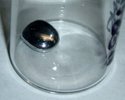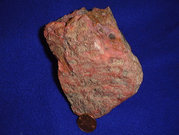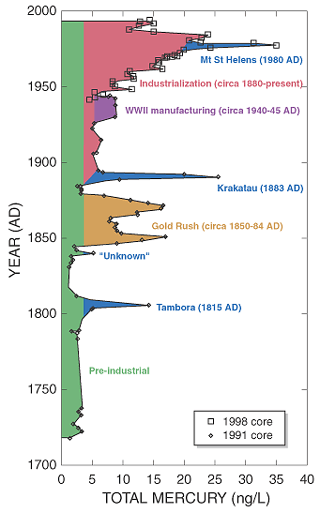CLUE 1
COMMON COMBO
On its own, the mystery element is a soft, lightweight metal. But finding its pure form in nature is mission impossible. Although it's the most abundant metal in Earth's crust, it's always found in compounds (two or more elements that are chemically combined). That's because the smallest unit of this element, or its atom, is highly reactive. It combines easily with other atoms. Most rocks contain compounds of this element.
GOT IT ALREADY? SCORE 100 POINTS. IF NOT, READ CLUE #2.
CLUE 2
CLASSIC FASHION
Ancient Minoans dyed clothing with natural materials such as plants, but these colorants didn't stick well to fabric. So the civilization (3000 to 1000 B.C.) used mordants, or substances used to bind dye to cloth. The most common mordant was made of the mystery element plus potassium, sulfur, and oxygen. The fabric was first treated with this substance. Then, dye bound to the mordant to create lasting, vibrant fashions.
NABBED THE ANSWER? SCORE 80 POINTS. STILL GUESSING? GO TO THE NEXT CLUE.
CLUE 3
SEEING RED
When a compound made of the mystery element and oxygen is exposed to high temperatures deep inside Earth, clear crystals of corundum--the second-hardest natural mineral--form. If traces of the element chromium are present, the crystals turn red, forming a pricey gem called ruby. In 1902, Auguste Verneuil, a French chemist, exposed a powdered form of the compound and chromium to scorching flames. The result: synthetic rubies, explains gemologist Hanna Cook-Wallace of Studio Jewelers in Wisconsin. Hint: Chromium is heavier, or has a higher atomic mass, than the mystery element.
GAME OVER ALREADY? SCORE 60 POINTS. STILL PLAYING? CHECK OUT CLUE #4.
CLUE 4
MONEYBAGS
In the 1850s, guests of Emperor Napoleon III of France dined with cutlery made from this metal. At the time, the pure element cost more than gold because it was so hard to separate from its ore, or metal-containing rock. The element lost its precious-metal status in 1886 when scientists found an easier method to extract it. They used electrolysis, sending electric currents to break the bonds linking the atoms that make up the mystery element-containing compound.
NAME IT NOW? SCORE 40 POINTS. OTHERWISE, READ ON.
CLUE 5
NO SWEAT
It's a main weapon in fighting underarm sweat. Some antiperspirants contain a compound made of the mystery element and chlorine, a member of the same period, or row, on the periodic table. When sweat reacts with the antiperspirant, the compound precipitates. That means that tiny particles of the compound separate from the antiperspirant mixture as solid particles. The particles move into the openings of your sweat glands, plugging them so that sweat can't escape.
HIT ON THE ANSWER? SCORE 20 POINTS. IF NOT, KEEP TRYING!
CLUE 6
STUCK ON YOU
To help scientists see distant objects, some telescopes contain mirrors coated with this metal. To form the coating, the mirror and metal are placed inside a vacuum, or airless space. When melted in a vacuum, the metal evaporates, or turns into vapor. This vapor covers the mirror's surface. And when temperatures cool, the vapor solidifies as a metal coating on the mirror, explains Andrew R. Barron, a chemistry professor at Rice University.
SCORE 10 POINTS IF YOU NAME THE ELEMENT WITH THE HELP OF SIX CLUES. STILL GUESSING? READ ON.
CLUE 7
LIGHTWEIGHT CHAMP
Hang-glider frames must be sturdy, yet light enough to set sail through the air. While metals such as iron and zinc may make strong frames, they are too heavy for liftoff. The solution: Melt in some of the mystery metal, which is light and soft, to create an alloy. The mixed-metal product has some of the toughness of the strong metals. "And it has the lightness of [the mystery element]," says Barron.
GUESS THE ELEMENT? SCORE 5 POINTS. IF NOT, TRY YOUR LAST CLUE.
CLUE 8
RERUN
By recycling one drink container made of this element, which has 13 protons, you'll save enough energy to power your television for three hours. That's because melting the containers to make new ones uses only 5 percent of the energy it takes to extract this mystery element from its ore. Saving energy is good news: Less pollutant gets spewed into the air.
GAME'S OVER. NOW TURN TO PAGE 20.
Anatomy of an Element
X--Atomic number
??--Element symbol
Name--Element name
X.XXXX--Average atomic mass
KEY DEFINITIONS:
ATOMIC NUMBER equals the number of protons (positively charged particles) in an atom's nucleus, or center. Every element contains a different number of protons, and so has a unique atomic number. In a neutral atom, the number of protons and the number of electrons (negatively charged particles) are equal.
ATOMIC MASS equals the number of protons plus the number of neutrons (uncharged particles) found in a single atom of an element. The atom's mass is in its nucleus, which houses both protons and neutrons.
[ILLUSTRATION OMITTED]
It's Your Choice
Test your chemistry IQ! Answer the following questions about elements and the periodic table.
1. Name that element! --
2. Two or more atoms are joined by
A currents.
B glues.
C bonds.
D links.
3. Which of the following elements is a metal?
A Silicon (Si)
B Argon (Ar)
C Hydrogen (H)
D Francium (Fr)
4. Which of the following is not found in group 13?
A Boron (B)
B Gallium (Ga)
C Indium (In)
D Polonium (Po)
5. Which of the following is not found in the same period as the others?
A Chromium (Cr)
B Tungsten (W)
C Nickel (Ni)
D Arsenic (As)
6. Of the following elements, which is the heaviest, solid metal?
A Iron (Fe)
B Zirconium (Zr)
C Mercury (Hg)
D Astatine (At)
ANSWER
1. aluminum 2. c 3. d 4. d 5. b 6. b
KITCHEN AID: In its pure form, this element is a shiny, silvery metal. It is commonly found in kitchen products.
DID YOU KNOW?
* Aluminum was originally called "aluminium." That was the accepted spelling in the United States until 1925, when the American Chemical Society officially changed it to "aluminum." Many European countries still refer to the element by its original name.
* Used aluminum cans can be recycled and returned to store shelves as new containers in as little as two months. CRITICAL THINKING:
* What are the pros and cons of using aluminum?
CROSS-CURRICULAR CONNECTIONS:
MATH: Keep tabs of how many hours of television your family watches, as well as how many aluminum cans of beverages your family consumes, in one week. If recycling one can could help save enough energy to power your television for three hours, calculate the following: By recycling that week's collection of cans, the saved energy could power what percentage of the week's television-watching time?
RESOURCES
* For basic information about aluminum, visit: www.webelements.com/webelements/elements/text/ Al/key.html
* For a student-friendly page on recycling aluminum cans, visit: www.recycleyourcans.org/
ANSWER
1.e 2. h 3. d 4. g 5. b 6. f 7. a 8. c
COPYRIGHT 2005 Scholastic, Inc.
COPYRIGHT 2005 Gale Group




